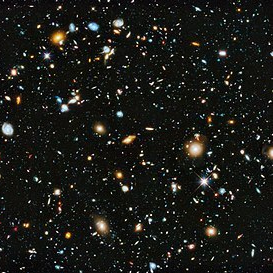Tag: astrophysics
Possibilities of Interstellar Travel
Journey to the Edge of the Universe
Gravitational Lensing
The Deflection of Light by Cosmic Bodies(relativity’s successful prediction continues)
Einstein’s initial success with explaining away the Mercury conundrum did not catapult him to superstar status. Those accolades actually came a few years later, with the verification of another of general relativity’s bold prognostications: Massive objects such as the sun should warp space-time enough to throw passing rays of light off course.
Einstein’s work piqued the interest of English astronomer Arthur Eddington, who recognized a great opportunity to test for this light deflection: On May 29, 1919, the sun would conveniently undergo a solar eclipse, which would block out its overwhelming glare, while passing close to a bright group of background stars called the Hyades. If Einstein were right, the sun’s presence would deflect their light, subtly shifting their position in the sky.Eddington arranged a pair of expeditions (one to Sobral, Brazil, and another to Principe, an island off the west coast of Africa) to look for the bending of the Hyades’ starlight as the eclipse shadow swept through West Africa and Brazil. Sure enough, the tiny predicted displacement of the stars’ light showed up.
The news of this discovery made headlines worldwide, with the Nov. 7 London Times proclaiming: “Revolution in Science/New Theory of the Universe/Newtonian Ideas Overthrown.” Einstein, remarkably for a physicist, became a household name.
Copenhagen interpretation Vs Many-worlds interpretation
The Copenhagen interpretation is an expression of the meaning of quantum mechanics that was largely devised in the years 1925 to 1927 by Niels Bohr and Werner Heisenberg. It remains one of the most commonly taught interpretations of quantum mechanics.
According to the Copenhagen interpretation, physical systems generally do not have definite properties prior to being measured, and quantum mechanics can only predict the probabilities that measurements will produce certain results. The act of measurement affects the system, causing the set of probabilities to reduce to only one of the possible values immediately after the measurement. This feature is known as wave function collapse.

There have been many objections to the Copenhagen interpretation over the years. These include: discontinuous jumps when there is an observation, the probabilistic element introduced upon observation, the subjectiveness of requiring an observer, the difficulty of defining a measuring device, and the necessity of invoking classical physics to describe the “laboratory” in which the results are measured.
Alternatives to the Copenhagen interpretation include the many-worlds interpretation, the De Broglie–Bohm (pilot-wave) interpretation, Quantum Bayesianism, and quantum decoherence theories.
Many-worlds interpretation
The many-worlds interpretation is an interpretation of quantum mechanics that asserts the objective reality of the universal wavefunction and denies the actuality of wavefunction collapse. Many-worlds implies that all possible alternate histories and futures are real, each representing an actual “world” (or “universe”). In layman’s terms, the hypothesis states there is a very large—perhaps infinite number of universes, and everything that could possibly have happened in our past, but did not, has occurred in the past of some other universe or universes. The theory is also referred to as MWI, the relative state formulation, the Everett interpretation, the theory of the universal wavefunction, many-universes interpretation, multiverse theory or just many-worlds.
Before many-worlds, reality had always been viewed as a single unfolding history. Many-worlds, however, views historical reality as a many-branched tree, wherein every possible quantum outcome is realised. Many-worlds reconciles the observation of non-deterministic events, such as random radioactive decay, with the fully deterministic equations of quantum physics.
In many-worlds, the subjective appearance of wavefunction collapse is explained by the mechanism of quantum decoherence, and this is supposed to resolve all of the correlation paradoxes of quantum theory, such as the EPR paradox and Schrödinger’s cat, since every possible outcome of every event defines or exists in its own “history” or “world”
